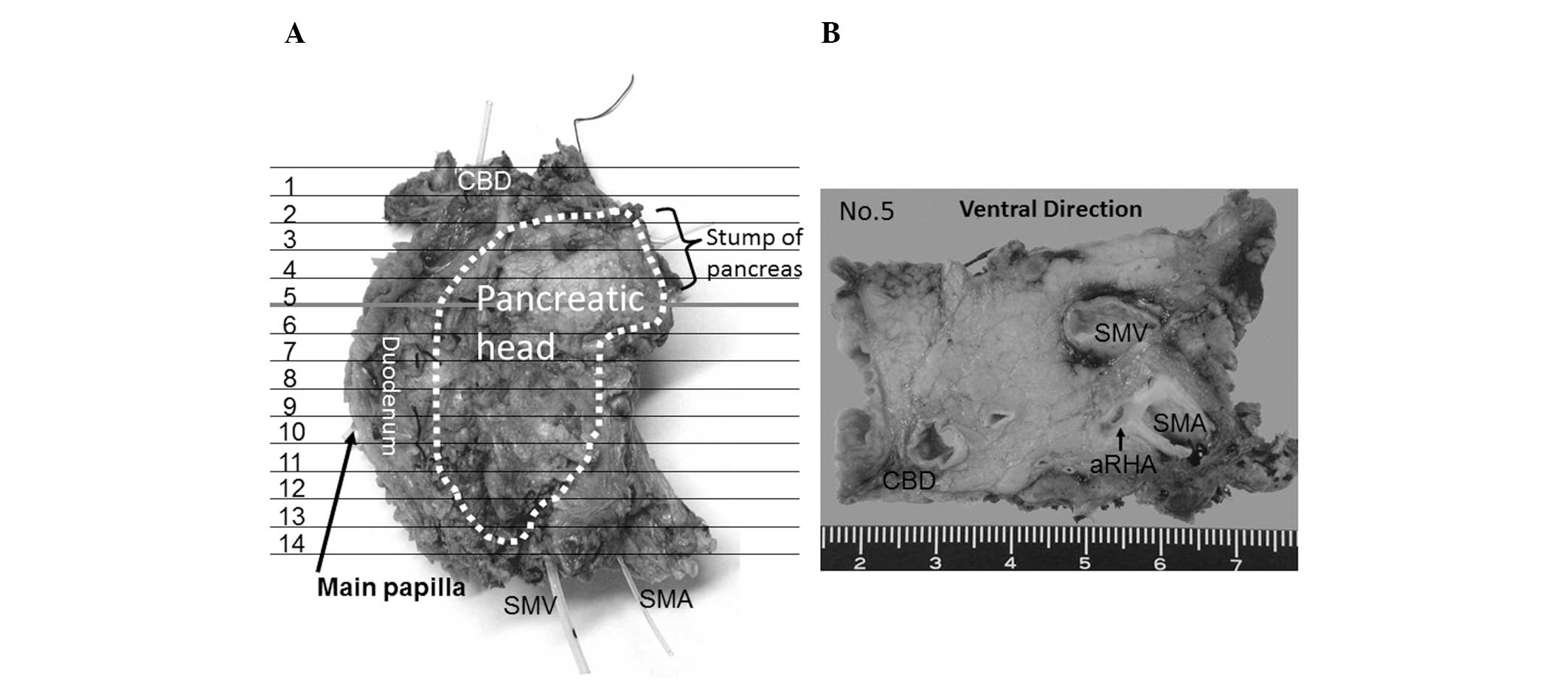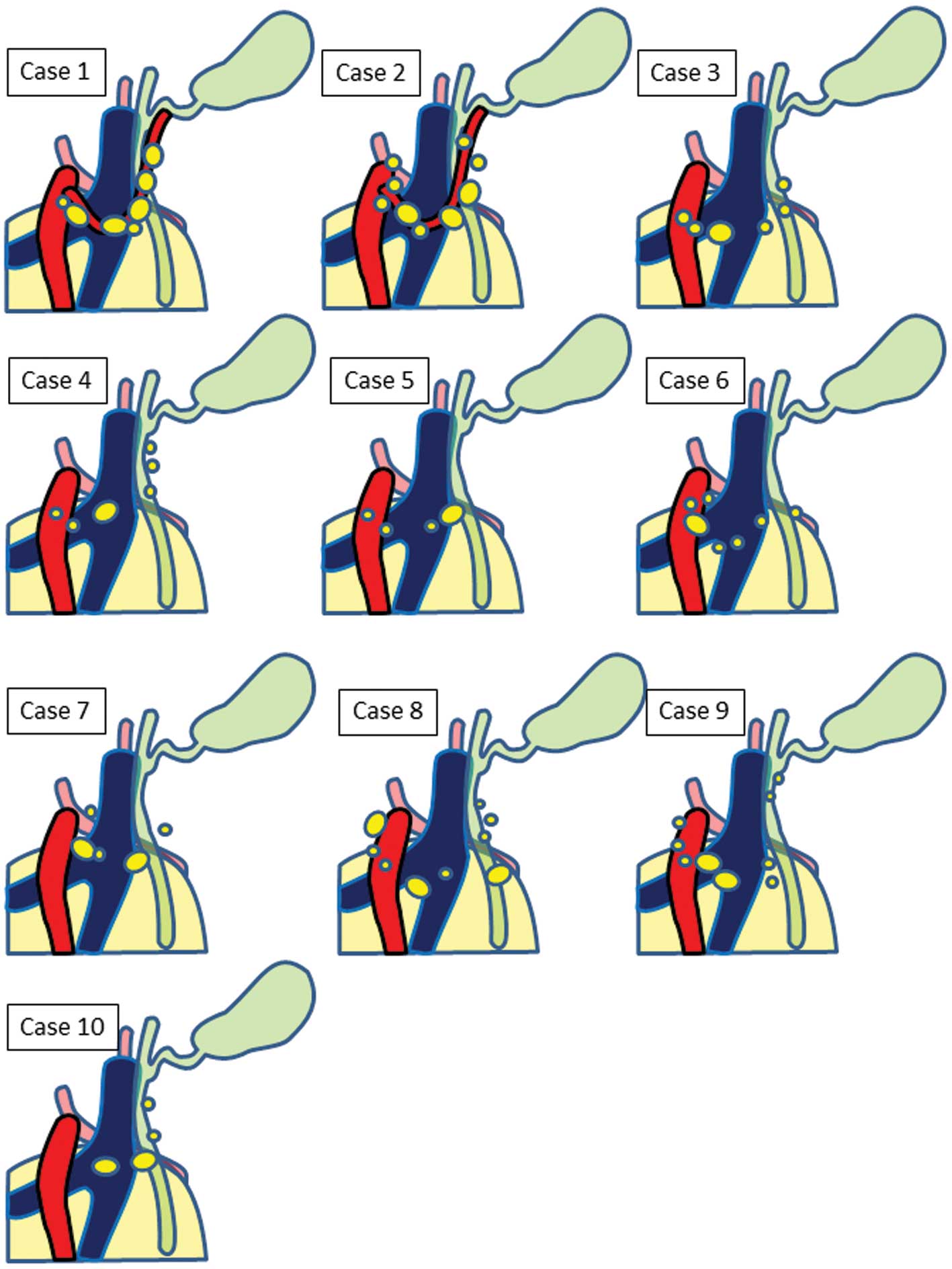Lymph node spread of gallbladder cancer from the perspective of embryologically‑based anatomy and significance of the lymphatic basin along the embryonic right hepatic artery
- Authors:
- Published online on: July 9, 2014 https://doi.org/10.3892/mco.2014.342
- Pages: 963-967
Abstract
Introduction
The prognosis of gallbladder cancer (GBC) with lymph node metastases is poor. The 5-year survival rate following surgical resection has been reported to be 65% for patients with no lymph node metastases and <30% for those with regional lymph node metastases (pN1) (1). In the pN1 group, lymph node metastases characteristically arise in the pericholedochal area or the posterosuperior pancreaticoduodenal region, rather than around the hepatic artery (2,3). However, no feeding arteries are present around the pericholedochal lymph nodes and posterosuperior pancreaticoduodenal lymph nodes (PPLNs), although lymph nodes and lymphatic vessels generally exist along a feeding artery (4–7).
We previously performed pancreaticoduodenectomy (PD) for pancreatic cancer in patients with an aberrant right hepatic artery (aRHA). In such cases, PPLNs were distributed along the aRHA. This artery is considered to represent an embryonic right hepatic artery (eRHA) that has not regressed. We hypothesized that the artery responsible for PPLNs would be the eRHA. If this hypothesis is accurate, lymphadenectomy for GBC should be performed based on the course of the eRHA (8). The aim of this study was to determine the artery supplying the PPLNs.
Materials and methods
Patients
Between 1997 and 2005, a total of 58 patients underwent PD for invasive pancreatic ductal cancer in the Department of Gastroenterologic Surgery at Kanazawa University. Among these cases, radical PD with major vessel resection [superior mesenteric artery (SMA) and superior mesenteric vein (SMV) resection] was performed in 18 patients for complete clearance of the soft tissues around these arteries (9). This study was approved by the Ethics Committee at our institution and was conducted in accordance with the Declaration of Helsinki.
Specimens
The resected specimens were immediately fixed in 10% neutral-buffered formaldehyde solution, then cut horizontally into 5-mm tissue blocks corresponding to computed tomography images, dehydrated and fixed in paraffin (Fig. 1). Finally, the specimens were cut into 5-μm sections and stained with hematoxylin and eosin. Eight cases in which evaluation of the lymphatic route was difficult, due to failed fixation of specimens or development of pancreatic cancer lesions, were excluded from our study. For the evaluation, the patients were divided into 2 groups, those with an aRHA and those with a normal hepatic artery and no aRHA. Each section was carefully examined under a light microscope to determine the presence of lymph nodes around the blood vessels and their distribution (Fig. 2).
Results
Cases
Among the 18 cases, 10 met the inclusion criteria and were examined for the pattern of lymphatic spread. Among these, 2 patients had an aRHA and 8 exhibited normal arterial branching. Representative examples of cases with typical distribution of lymph nodes are shown in Fig. 2. In these specimens, removal of the duodenum, pancreatic head, bile duct, SMV, SMA and surrounding connective tissue by en bloc resection allowed for the determination of the lymphatic route between the area surrounding the SMA and the pericholedochal area (9).
Arterial pattern
Examination of the course of the arteries in the 2 cases with an aRHA revealed that the vessel branched from the right side of the SMA (Fig. 2C) and crossed dorsal to the SMV and pancreatic head (Fig. 2B), then proceeded to the right side of the bile duct (Fig. 2A). Observation of the lymph node distribution revealed enlarged PPLNs along the aRHA in both patients (Fig. 3). In the 8 patients with normal hepatic artery branching, enlarged lymph nodes were observed in the pericholedochal area, dorsal to the pancreatic head, in the retroportal area and on the right side of the SMA (Fig. 3). Interestingly, the lymph node distribution closely resembled that of cases with an aRHA, appearing with a similar distribution, but where a regressed eRHA would have passed (Fig. 4).
Discussion
Radical lymph node dissection for GBC is crucial (10) and understanding the pattern of lymph node metastatic spread from GBC is mandatory for surgeons (11,12). This study demonstrated that PPLNs were distributed along the aRHA. In patients with a normal right hepatic artery, these lymph nodes were also distributed in a similar manner, suggesting distribution along the regressed eRHA.
During early human fetal life, 3 vessels exist, the embryonic left, middle and right hepatic arteries (13). During the developmental process, the embryonic left and right hepatic arteries regress and the middle hepatic artery persists. By adulthood, the embryonic middle hepatic artery has differentiated into the right, middle and left hepatic arteries. However, in some cases the eRHA persists without regression, representing an aRHA. The lymphatics travel primarily with blood vessels (6,7). Even if the artery completely regresses, the accompanying lymphatic vessels, lymph nodes and nerves presumably remain (4). We therefore considered that the enlarged lymph nodes observed in cases with normal hepatic arterial branching were compatible with lymph nodes along a regressed eRHA.
An understanding of this concept may contribute to lymphadenectomy for GBC. As the standard surgical treatment in colorectal cancer, intestinal resection and regional lymphadenectomy, including feeding arteries, is considered essential (13,14). In GBC up to stage IIa, the frequency of lymph node metastasis in the pericholedochal area has been reported to be higher compared to that of lymph node metastasis around the hepatic artery (2,3). The lymphatic pathway of PPLNs has been called ‘the right route of lymphatic drainage of the gallbladder’ in Japan and has been considered as the main lymphatic route requiring resection in the treatment of GBC (12,15,16). From the present study, the right route is considered part of the route of the eRHA. To completely remove the lymphatic basin in the eRHA route, resection of the nodes in the pericholedochal area, posterosuperior pancreaticoduodenal area and retroportal area should also be performed (14). This consideration is undoubtedly a key reason as to why the addition of PD is associated with improved prognosis for patients with GBC (17–19). We hypothesize that PD allows en bloc resection of the lymphatic basin along the eRHA. However, performing the surgery with awareness of the fetal pathway of lymphatic vessels may enable surgery with appropriate lymphadenectomy, without PD, for GBC.
Clearly, this hypothesis requires confirmation by further embryological studies; however, we suggest that surgery with an awareness of lymph node metastasis along the eRHA may lead to improved prognosis for patients with GBC and we suggest that the feeding artery for PPLNs is either the regressed eRHA or an aRHA persisting without regression.
References
|
Miyakawa S, Ishihara S, Horiguchi A, Takada T, Miyazaki M and Nagakawa T: Biliary tract cancer treatment: 5,584 results from the Biliary Tract Cancer Statistics Registry from 1998 to 2004 in Japan. J Hepatobiliary Pancreat Surg. 16:1–7. 2009. View Article : Google Scholar : PubMed/NCBI | |
|
Tsukada K, Kurosaki I, Uchida K, et al: Lymph node spread from carcinoma of the gallbladder. Cancer. 80:661–667. 1997. View Article : Google Scholar : PubMed/NCBI | |
|
Nagakawa T, Kayahara M, Ikeda S, et al: Biliary tract cancer treatment: results from the Biliary Tract Cancer Statistics Registry in Japan. J Hepatobiliary Pancreat Surg. 9:569–575. 2002. View Article : Google Scholar : PubMed/NCBI | |
|
Yi SQ, Shimokawa T, Akita K, Ohta T, Kayahara M, Miwa K and Tanaka S: Anatomical study of the pancreas in the house musk shrew (Suncus murinus), with special reference to the blood supply and innervation. Anat Rec A Discov Mol Cell Evol Biol. 273:630–635. 2003.PubMed/NCBI | |
|
Cha YR, Fujita M, Butler M, Isogai S, Kochhan E, Siekmann AF and Weinstein BM: Chemokine signaling directs trunk lymphatic network formation along the preexisting blood vasculature. Dev Cell. 22:824–836. 2012. View Article : Google Scholar : PubMed/NCBI | |
|
Geudens I, Herpers R, Hermans K, et al: Role of delta-like-4/Notch in the formation and wiring of the lymphatic network in zebrafish. Arterioscler Thromb Vasc Biol. 30:1695–1702. 2010. View Article : Google Scholar : PubMed/NCBI | |
|
Liao S, Padera TP and Jain RK: Notch leads lymphatics and links them to blood vessels. Arterioscler Thromb Vasc Biol. 30:1682–1683. 2010. View Article : Google Scholar : PubMed/NCBI | |
|
Miwa K, Kinami S, Taniguchi K, Fushida S, Fujimura T and Nonomura A: Mapping sentinel nodes in patients with early-stage gastric carcinoma. Br J Surg. 90:178–182. 2003. View Article : Google Scholar : PubMed/NCBI | |
|
Kitagawa H, Ohta T, Makino I, et al: Carcinomas of the ventral and dorsal pancreas exhibit different patterns of lymphatic spread. Front Biosci. 13:2728–2735. 2008. View Article : Google Scholar : PubMed/NCBI | |
|
Wang JD, Liu YB, Quan ZW, Li SG, Wang XF and Shen J: Role of regional lymphadenectomy in different stage of gallbladder carcinoma. Hepatogastroenterology. 56:593–596. 2009.PubMed/NCBI | |
|
Uesaka K, Yasui K, Morimoto T, et al: Visualization of routes of lymphatic drainage of the gallbladder with a carbon particle suspension. J Am Coll Surg. 183:345–350. 1996.PubMed/NCBI | |
|
Shirai Y, Yoshida K, Tsukada K, Ohtani T and Muto T: Identification of the regional lymphatic system of the gallbladder by vital staining. Br J Surg. 79:659–662. 1992. View Article : Google Scholar : PubMed/NCBI | |
|
Chen SL and Bilchik AJ: Resecting lymph nodes in colon cancer: more than a staging operation? Ann Surg Oncol. 14:2175–2176. 2007. View Article : Google Scholar : PubMed/NCBI | |
|
Takeuchi H and Kitagawa Y: Sentinel node navigation surgery in patients with early gastric cancer. Dig Surg. 30:104–111. 2013. View Article : Google Scholar : PubMed/NCBI | |
|
Ito M, Mishima Y and Sato T: An anatomical study of the lymphatic drainage of the gallbladder. Surg Radiol Anat. 13:89–104. 1991. View Article : Google Scholar : PubMed/NCBI | |
|
Deki H and Sato T: An anatomic study of the peripancreatic lymphatics. Surg Radiol Anat. 10:121–135. 1988. View Article : Google Scholar : PubMed/NCBI | |
|
Shirai Y, Ohtani T, Tsukada K and Hatakeyama K: Pancreaticoduodenectomy for gallbladder cancer with peripancreatic nodal metastases. Hepatogastroenterology. 44:376–377. 1997.PubMed/NCBI | |
|
Doty JR, Cameron JL, Yeo CJ, Campbell K, Coleman J and Hruban RH: Cholecystectomy, liver resection, and pylorus-preserving pancreaticoduodenectomy for gallbladder cancer: report of five cases. J Gastrointest Surg. 6:776–780. 2002. View Article : Google Scholar : PubMed/NCBI | |
|
Shirai Y, Wakai T and Hatakeyama K: Radical lymph node dissection for gallbladder cancer: indications and limitations. Surg Oncol Clin N Am. 16:221–232. 2007. View Article : Google Scholar : PubMed/NCBI |













